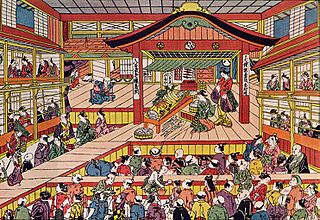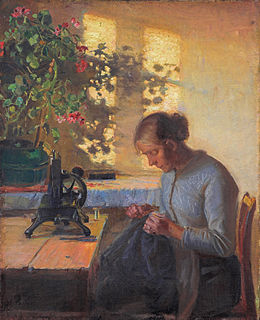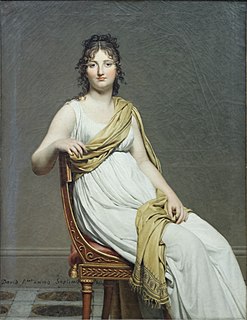Related Research Articles
The banjo is a stringed instrument with a thin membrane stretched over a frame or cavity to form a resonator. The membrane is typically circular, and usually made of plastic, or occasionally animal skin. Early forms of the instrument were fashioned by African-Americans in the United States. The banjo is frequently associated with folk and country music, and has also been used in some rock, pop and hip-hop. Several rock bands, such as the Eagles, Led Zeppelin, and The Allman Brothers, have used the five-string banjo in some of their songs. Historically, the banjo occupied a central place in Black American traditional music and the folk culture of rural whites before entering the mainstream via the minstrel shows of the 19th century. Along with the fiddle, the banjo is a mainstay of American styles of music, such as Bluegrass and old-time music. It is also very frequently used in traditional ("trad") jazz. Banjo is also a common instrument for Caribbean genres like Biguine, Calypso and Mento.

Dance is a performing art form consisting of sequences of movement, either improvised or purposefully selected. This movement has aesthetic and often symbolic value. Dance can be categorized and described by its choreography, by its repertoire of movements, or by its historical period or place of origin.

Poetry is a form of literature that uses aesthetic and often rhythmic qualities of language − such as phonaesthetics, sound symbolism, and metre − to evoke meanings in addition to, or in place of, a prosaic ostensible meaning. A poem is a literary composition, written by a poet, utilising this principle.

Romanticism was an artistic, literary, musical, and intellectual movement that originated in Europe towards the end of the 18th century, and in most areas was at its peak in the approximate period from 1800 to 1850. Romanticism was characterized by its emphasis on emotion and individualism as well as glorification of all the past and nature, preferring the medieval rather than the classical. It was partly a reaction to the Industrial Revolution, the social and political norms of the Age of Enlightenment, and the scientific rationalization of nature—all components of modernity. It was embodied most strongly in the visual arts, music, and literature, but had a major impact on historiography, education, chess, social sciences, and the natural sciences. It had a significant and complex effect on politics, with romantic thinkers influencing conservatism, liberalism, radicalism, and nationalism.

Ukiyo-e is a genre of Japanese art which flourished from the 17th through 19th centuries. Its artists produced woodblock prints and paintings of such subjects as female beauties; kabuki actors and sumo wrestlers; scenes from history and folk tales; travel scenes and landscapes; flora and fauna; and erotica. The term ukiyo-e translates as "picture[s] of the floating world".

Sewing is the craft of fastening or attaching objects using stitches made with a sewing needle and thread. Sewing is one of the oldest of the textile arts, arising in the Paleolithic era. Before the invention of spinning yarn or weaving fabric, archaeologists believe Stone Age people across Europe and Asia sewed fur and leather clothing using bone, antler or ivory sewing-needles and "thread" made of various animal body parts including sinew, catgut, and veins.

A corset is a support garment commonly worn to hold and train the torso into a desired shape, traditionally a smaller waist or larger bottom, for aesthetic or medical purposes, or support the breasts. Both men and women are known to wear corsets, though this item was for many years an integral part of women's wardrobes.

The fancy rat is the domesticated form of Rattus norvegicus, the brown rat, and the most common species of rat kept as a pet. The name fancy rat derives from the idea of animal fancy or the phrase "to fancy". Wild-caught specimens that become docile and are bred for many generations still fall under the fancy type.
Wallpaper is a material used in interior decoration to decorate the interior walls of domestic and public buildings. It is usually sold in rolls and is applied onto a wall using wallpaper paste. Wallpapers can come plain as "lining paper", textured, with a regular repeating pattern design, or, much less commonly today, with a single non-repeating large design carried over a set of sheets. The smallest rectangle that can be tiled to form the whole pattern is known as the pattern repeat.

The Italianate style was a distinct 19th-century phase in the history of Classical architecture. In the Italianate style, the models and architectural vocabulary of 16th-century Italian Renaissance architecture, which had served as inspiration for both Palladianism and Neoclassicism, were synthesised with picturesque aesthetics. The style of architecture that was thus created, though also characterised as "Neo-Renaissance", was essentially of its own time. "The backward look transforms its object," Siegfried Giedion wrote of historicist architectural styles; "every spectator at every period—at every moment, indeed—inevitably transforms the past according to his own nature."

Fashion in the period 1795–1820 in European and European-influenced countries saw the final triumph of undress or informal styles over the brocades, lace, periwigs and powder of the earlier 18th century. In the aftermath of the French Revolution, no one wanted to appear to be a member of the French aristocracy, and people began using clothing more as a form of individual expression of the true self than as a pure indication of social status. As a result, the shifts that occurred in fashion at the turn of the 19th century granted the opportunity to present new public identities that also provided insights into their private selves. Katherine Aaslestad indicates how "fashion, embodying new social values, emerged as a key site of confrontation between tradition and change."

The I-house is a vernacular house type, popular in the United States from the colonial period onward. The I-house was so named in the 1930s by Fred Kniffen, a cultural geographer at Louisiana State University who was a specialist in folk architecture. He identified and analyzed the type in his 1936 study of Louisiana house types.

Royal Copenhagen, officially the Royal Porcelain Factory, is a Danish manufacturer of porcelain products and was founded in Copenhagen in 1775 under the protection of Danish Dowager Queen Juliane Marie. It is recognized by its factory mark, the three wavy lines above each other, symbolizing Denmark's three straits: Storebælt, Lillebælt and Øresund.

A fashion plate is an illustration demonstrating the highlights of fashionable styles of clothing. Traditionally they are rendered through etching, line engraving, or lithograph and then colored by hand. To quote historian James Laver, the best of them tend to "reach a very high degree of aesthetic value."

The nineteenth century marks the period beginning January 1, 1801 and ends December 31, 1900.

A dress is a garment traditionally worn by women or girls consisting of a skirt with an attached bodice. It consists of a top piece that covers the torso and hangs down over the legs. A dress can be any one-piece garment containing a skirt of any length, and can be formal or casual.

The history of immigration to the United States details the movement of people to the United States, from the colonial era to the present. The United States experienced successive waves of immigration, particularly from Europe, and later from Asia and Latin America. Colonial era immigrants often paid the cost of transoceanic transportation by becoming indentured servants where the new employer paid the ship's captain. Starting in the late 19th century immigration was restricted from China and Japan. In the 1920s restrictive immigration quotas were imposed, although political refugees had special status. Numerical restrictions ended in 1965. In recent years the largest numbers have come from Asia and Central America.

English Americans, or Anglo-Americans, are Americans whose ancestry originates wholly or partly in England. In the 2019 American Community Survey, 23.59 million self-identified as being of English origin.

The Campeche is a reclining, non-folding, sling-seat chair with a distinctive side-placed curule base. In North America, they are named for the Campeche region of Mexico’s Yucatán Peninsula, and were popular in the Americas during the early nineteenth-century. Similar versions of the form are found throughout Europe, such as the Schinkel writing chair at Schloss Charlottenburg in Berlin. Other related forms include the “planter’s chair” or “bootjack” which is associated with equatorial climes and plantation-based societies.

Ipswich lace is a historical fashion accessory, the only known American hand-made bobbin lace to be commercially produced. Centered in the coastal town of Ipswich, Massachusetts north of Boston, a community of lacemaking arose in the 18th century. Earliest known records indicate that lace produced by local women was used to barter for goods in the 1760s, as denoted by ledger account books belonging to local merchants. These laces were sold in the region from Boston to Maine.
References
- ↑ Priddy, Sumpter (2004). American Fancy: Exuberance in the Arts, 1790-1840. Chipstone Foundation. p. 267. ISBN 978-0-9724353-9-0 . Retrieved 3 August 2010.
- 1 2 Moustaki, Nikki (2004). "Tickling the American Fancy". Humanities. 25 (3). Archived from the original on 29 May 2010. Retrieved 3 August 2010.